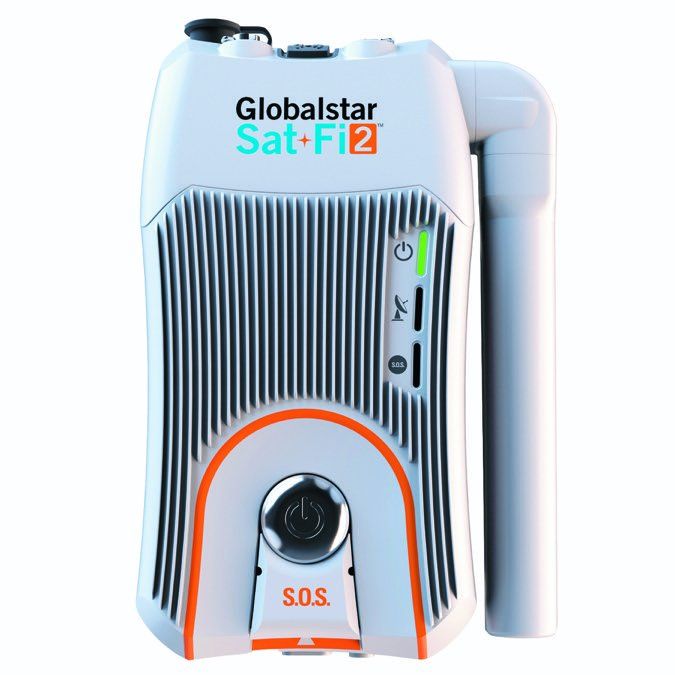When we evaluated Globalstar’s first-gen Sat-Fi cabin satcom device in the December 2014 Aviation Consumer we were underwhelmed with its performance and form factor. But the latest-gen Sat-Fi2 is worlds ahead.
It needs to be because there is solid competition from Garmin’s inReach line of portable satcoms. There’s also the BendixKing AeroWave portable. With voice communications, Wi-Fi, an SOS function and hardware that’s cockpit-friendly, we think the Sat-Fi2 is a credible contender in the price-sensitive portable satcom market. Here’s a look.
The Network
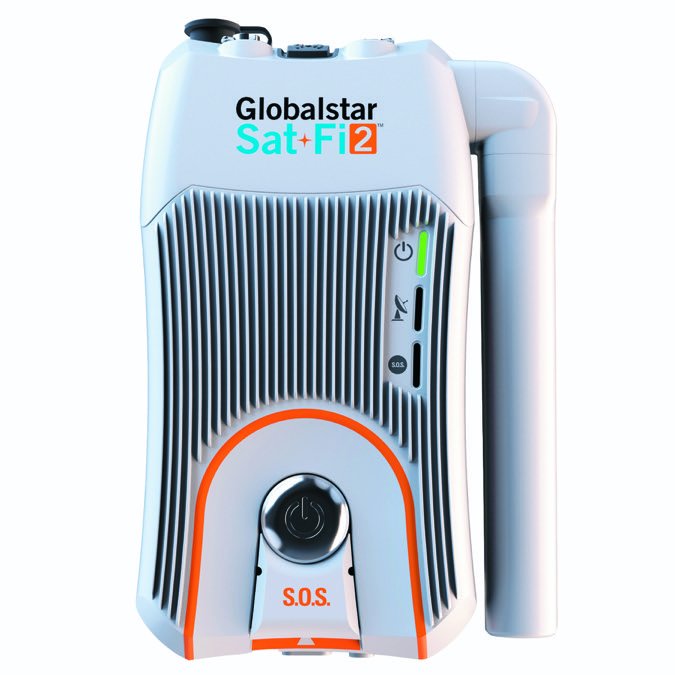
Globalstar’s LEO (low earth orbit) constellation forms a network with 24 ground stations that serve as a bridge to traditional terrestrial telecommunications networks on six continents, providing communications to over 120 countries. The current-generation LEO satellite constellation delivers low-speed bandwidth (72 Kbps), not dissimilar to fast dialup modems-good for voice calls, text messages, short emails and textual websites. Don’t plan on downloading videos and other big files. That level of performance is best left to the more expensive geostationary satellite-based terrestrial broadband networks.
Still, the next generation of LEO com satellites promise to deliver connectivity upward of 1 Mbps, performance we’re still waiting on. Worth mentioning is Globalstar was an early market player with reasonably affordable bandwidth. The SPOT Connect and SPOTx communicator use LEO satellites to deliver short messages through texting, email, Twitter and Facebook.
Globalstar SPOT products transmit more than 1.3 billion messages a year, while connecting devices in locations beyond cellular coverage. According to the company there have been more than 6100 rescues initiated worldwide using SPOT satcom products.
Globalstar’s end-to-end service comprises the Sat-Fi2 hotspot hardware, the Sat-Fi application installed on tablets, smartphones or laptops, a firmware download application, the My Account website and a satellite airtime subscription. The Sat-Fi2 device is assigned a 10-digit telephone number and through the Sat-Fi application is able to deliver satellite telephone services (including voicemail) to a smartphone, tablet or laptop.
Better Hardware
The Sat-Fi2 is a small device that can stash easily in a flight bag or a big map pocket or be temporarily placed up on the glareshield. The device weighs 12.6 ounces and measures 2.9 by 1.5 by 5.8 inches and has an integral flip-up satellite/Wi-Fi antenna. The device has a built-in lithium polymer battery, which delivers up to two hours of talk time and 28 hours when in standby. A Micro-USB port is used to both charge the battery and update the device’s firmware.
The Sat-Fi2 is dust- and water-resistant and can withstand a high force of shock with an operating temperature as low as 4 degrees and as high as 95 degrees F. It operates as high as 21,320 feet MSL. Two additional hardware ports provide connectivity to an external satellite antenna (non-aviation)and DC power.
Ship’s power can be delivered through a USB cigarette lighter adapter or a panel-mounted (and TSO’d) USB charging port, which connects to the device’s Micro-USB port. While powered on, the Sat-Fi2 will draw power from the battery while it’s being charged. The external power port will accommodate a 10- to 48-volt power source-either an auxiliary power adapter or hardwired into aircraft’s electrical using fuse protection. When powered by the external power port, the internal battery is not charged. With an onboard battery, power is natively backed up (think uninterrupted power supply) when powered from the external power port.
To charge the device, connect the supplied Micro-USB data/power cable to the Sat-Fi2 USB port and plug it into a computer or the supplied AC power adapter. The Sat-Fi2 will perform a self test by flashing the status LEDs in a right-to-left then left-to-right sequence. If the power LED is blinking red, the battery requires further charging. Let the device charge until the power LED turns green. After charging, the USB data/power port cover needs to be properly installed (turn the D-ring screws clockwise) to ensure the device’s water resistance. The internal battery is not field replaceable.
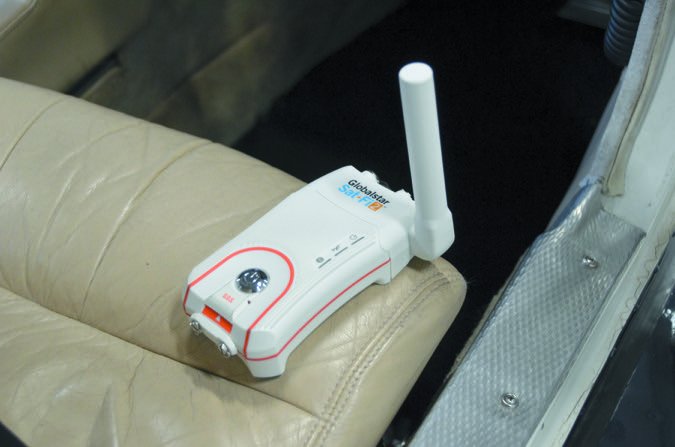
Similar to a GPS receiver, the Sat-Fi2 requires an unobstructed view of the sky. For our trial we flew with the Sat-Fi2 in both a Commander 114 and Cessna 172, placing it on the glareshield of the aircraft, and the device was able to connect to the LEO satellites. The antenna needs to be fully extended and pointed straight for best reception.
In 2016, Globalstar released a TSO-certified satellite antenna for Part 23 non-pressurized aircraft. While this antenna supports the Globalstar first-generation Sat-Fi product, it doesn’t work with the Sat-Fi2. Globalstar is working on a docking station for the latest Sat-Fi2, which should be available in the second part of 2019. The Sat-Fi2 antenna/power module is removable, allowing the electronics pod to be attached to the docking station, which will provide hardwired connections to both ship’s power and an external satellite antenna, and will be equipped with a storage area for the antenna/power module.
Wi-Fi and Firewall
The Sat-Fi2’s built-in Wi-Fi access point will allow up to eight personal smart devices to connect and share access to the satellite network, creating a private network in the aircraft. The Wi-Fi radio operates on 2.4 GHz (2400 to 2500 MHz). During the initial setup, the Wi-Fi SSID (network name) and WPA2 password get configured.
Here’s a tip: Document the SSID and password in order to easily connect guest users to the device without fuss. This will allow an appropriate security posture to ensure that user devices attached to the private network or access to the LEO satellite network are not compromised. In ideal conditions, the Wi-Fi range is roughly 100 feet-obviously sufficient in most all cabins.
With security front and center in the world of cabin Wi-Fi, the Sat-Fi2 has a built-in firewall to control both traffic and allow (or block) access to all or specific web servers. Consider that the majority of corporate IT departments will provide guidance in order to provide alignment to your company’s acceptable internet use guidelines. The firewall allows domain names, IP addresses or port numbers to be controlled. This provides a reasonable security posture when properly configured. Configuration changes to the firewall can be made through the Globalstar Sat-Fi app when attached with the owner account and through the My Account utility on the website.
The Sat-Fi2’s main application, called Sat-Fi, creates a walled garden that allows access to the internet, email and SMS texting only through the Sat-Fi app. To control bandwidth costs, applications native to your tablet, smartphone and laptop computer will not have access to the internet. Smartphones and tablets-Apple iOS devices in particular-are inherently network chatty. As an example, background applications such as Apple Photos will upload photos and videos to iCloud in order to facilitate photostream sharing to other Apple iOS devices, while applications such as Facebook, Twitter and LinkedIn are graphically heavy.
With access to the open internet, bandwidth utilization and cost could be quite heavy if these applications were provided with native access. Globalstar eliminates the added overhead of these application background updates and synchronization (to the cloud) by using this walled garden approach. This approach to containing application access to the internet (and network traffic) allows the use of a smart device without making any configuration changes. This is ideal when transitioning from the aircraft to an FBO, to an office and home, allowing the device to switch between LTE and terrestrial Wi-Fi networks.
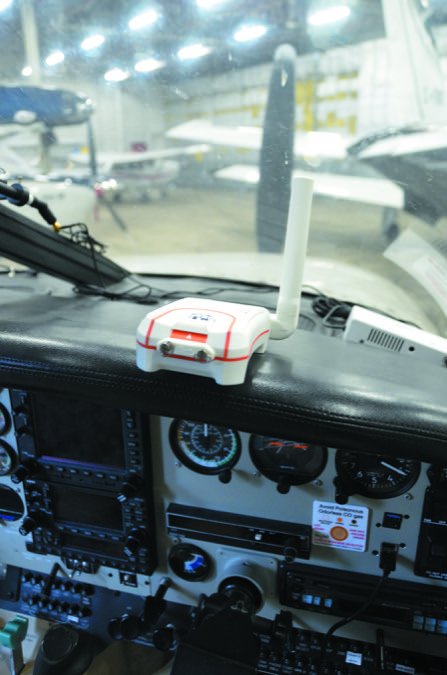
There are two types of user accounts: owner account-the actual owner of the device, which has administrator access-and a guest user account. Both account types are able to make voice calls, send and receive text messages, access email, make social media posts to Twitter and view local weather. The owner account has administrative privileges, which includes the ability to change the Wi-Fi password, delete messages in the queue and have access to the My Account utility. The Sat-Fi application allows the user to select the type of login, either administrator or guest.
Voice Calling
The Sat-Fi2 device is assigned a 10-digit telephone number aligning to the country in which it was registered. As an example, with a U.S. telephone number a user is able to call another U.S. telephone number without incurring long-distance charges. The duration of the telephone call will be deducted from the pool of minutes included in the service plan. The physical location of the Sat-Fi2 device does not matter during the telephone call. However, with a U.S. telephone number calling an international telephone number, long-distance rates will apply.
To use the satellite telephone services, simply launch the Sat-Fi app on your smart device or computer, log in to the app, select Telephone and enter the telephone number you wish to call. Include the country code and area code (1-416-555-1212, for example).
The call experience will be similar to a cellular telephone call. With the LEO satellites in orbit at 485 miles, the IP latency will be high. Globalstar uses G.711 voice compression to minimize the amount of bandwidth required to support the telephone call and deal with high IP latency. Inbound callers are able to call you by simply dialing your telephone number from a mobile telephone or landline. If the Sat-Fi app is not running or you choose to ignore the call, the phone call will be directed to voicemail. You are able retrieve voicemails through either utilizing the Sat-Fi app or using a landline or mobile telephone. We found the Sat-Fi2’s voice quality to be similar to a decent cellular phone.
SOS and SAT Browser
Like Globalstar’s SPOTx and SPOT Gen 3 satellite communicators, the Sat-Fi2 provides SOS notification to a 24/7 emergency notification center. An SOS message may be initiated either directly on the Sat-Fi2 device or from the SOS option on the Sat-Fi application.
Once an SOS is initiated, the Sat-Fi2 will continuously send your GPS position every five minutes until the SOS is canceled or the device is powered off. While SOS is active, the Sat-Fi2 should remain outside where it has a 360-degree clear view of the sky with no obstructions in order to maintain network connectivity. Of course, the SOS mode should only be used during life-threatening emergencies. Sending bogus SOS messages may subject you to additional charges.
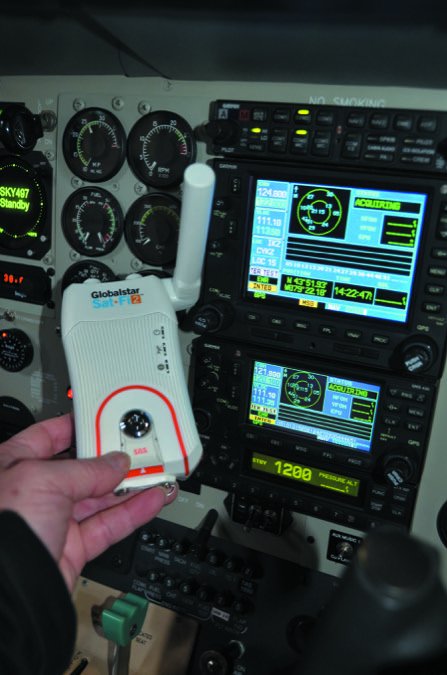
The rescue begins by pressing the SOS button, which is behind a protective cover that’s prominently marked (the button must be pressed for three seconds), or through the SOS icon on the app’s main screen. Once activated, the SOS icon will be displayed on the status bar and the SOS notification message will be sent every 2.5 minutes until it is acknowledged. SOS may be canceled one of two ways: Press the SOS hard button for three seconds or select Cancel SOS from the SOS screen within 10 seconds of activating the SOS. The SOS notification to the authorities will not be canceled if the device is powered off or if the Sat-Fi app is turned off.
The Sat-Fi2 sends a notification with the device’s GPS coordinates to the GEOS worldwide monitoring center (www.geosworldwide.com). GEOS provides SOS monitoring and emergency dispatch through its dedicated International Emergency Response Coordination Center (IERCC) based in Houston, Texas. The IERCC is staffed 24/7 with trained personnel who have access to first responders. The average response time from the receipt of your SOS message until referring an emergency responder is 11 minutes. In countries where search and rescue (SAR) services are provided on a fee-for-service basis, you can upgrade to the GEOS member benefit for reimbursement of up to $100,000 in SAR expenses at an annual cost of $24.99.
Once an SOS message has been received, the IERCC calls your emergency contact(s) to determine if it is a false alarm. It locates and notifies an emergency responder and then maintains an open line of communication, including providing updates of your location. The IERCC will also keep your emergency contact(s) informed. SAR leaders believe that when stranded in the remote regions, two-way communications contribute to a positive state of mind, which improves survival outcomes. We agree.
The Sat-Fi2, through the application, will put your smart device into SOS mode. At the bottom of the SOS screen, a message box is displayed allowing you to type real-time messages to IERCC emergency responders.
Service Plan Rates
As with other Globalstar products, service plans can be paid annually or monthly. Globalstar does not offer a discount for prepaying the annual plans. The plans are differentiated based upon the number of voice minutes, text messages and data (MB) that’s used in a month. Unused airtime cannot be rolled over to the next month. Monthly service plans range from $39.99 to $199.99 per month, including between 40 to 500 voice minutes, 5 to 75 MB of data and between 25 to 500 SMS text messages. Additional voice time is $0.99 per minute. If there is more than one Sat-Fi2 on the same account, the minutes are pooled.
Our Wish List
Overall, the new Sat-Fi2 is a big improvement over the first-gen device. After using Sat-Fi2 and collaborating with Globalstar product management folks, we recommended a few product enhancements that hopefully can be added to the product roadmap.
This includes hidden SSIDs, the ability to drop virtual breadcrumbs (like you can with the SPOT product), compatibility with an external TSO’d satellite antenna (something the company already has in hand), extending a Yippy web browser to aviation applications for weather data, plus including EFBs into the walled garden ecosystem, allowing those EFB applications to benefit from satellite connectivity.
Saying all that, we think the Sat-Fi2 can offer sizable utility for flying outside of cellular coverage, and when flying in remote locations. The obvious benefit with any satcom device is you can use it both in and out of the aircraft.
On flying trips to the Bahamas, for example, we have found cellular services to be nonexistent outside of Nassau and Freeport. Products like the Sat-Fi2 fill that gap. For the busy executive, IP connectivity allows the office umbilical cord to stay connected.
Like SPOT3 and SPOTx, the website updater application, the account activation process and the Sat-Fi application are easy and intuitive to use.
Despite high-priced data charges and aging satellite infrastructure, the portable satcom transceiver market has become competitive and crowded. If you want a portable unit with a keyboard for texting, the Globalstar Sat-Fi2 won’t do it-you’ll need to execute this from a smartphone or tablet.
But for on-the-fly ubiquitous access to instant messaging, emails, voice calling and websites that can be delivered whether on the ground, at an airport or at 18,000 feet, it’s one reliable way of maintaining the cyber umbilical cord, with some limitations. At $499, we think the Globalstar Sat-Fi2 hardware is reasonably priced and performs well enough to do just that.
Contributor Phil Lightstone is a longtime IT and telecommunications professional, aviation writer and an active pilot.

